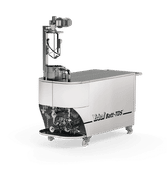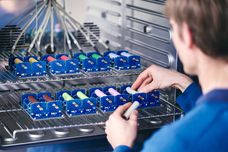The Battery of the Future: New storage material improves energy density of lithium-ion battery
Advertisement
High-performance energy storage technologies for the automotive industry or mobile phone batteries and notebooks providing long battery times - these visions of the future are being brought one step nearer to the present by scientists from Graz University of Technology. Researchers at the Institute for chemistry and Technology of Materials have developed a new method that utilises silicon for lithium-ion batteries.
Its storage capacity is ten times higher than the graphite substrate which has been used up to now, and promises considerable improvements for users. The new findings - which came to light in the "NanoPoliBat" EU project - have been recently submitted to the patent office by researchers together with their co-operation partner Varta Microbattery.
Modern electronic devices need more energy and even the automotive industry is hankering after increasingly powerful energy storage systems. The technological development of battery research has been inadequate for some time now. "A real revolution is needed for the development of the next generation. We need new storage materials for lithium-ion batteries", explains battery researcher Stefan Koller, who is familiar with the topic from his doctoral thesis. Together with colleagues from science and industry, he has managed to develop such a substrate material for electrochemical reactions at a low price.
Silicon gel on graphite
In the newly developed process, researchers utilise a silicon-containing gel and apply it to the graphite substrate material. "In this way the graphite works as a buffer, cushioning the big changes in volume of the silicon during the uptake and transfer of lithium ions", explains Koller. Silicon has a lithium-ion storage capacity some ten times higher than the up-to-now commercially used graphite. The new material can thus store more than double the quantity of lithium ions without changes to the battery lifetime. This method is far cheaper than the previous ones in which silicon is separated in the gas phase. The challenge lies in the poor storage density of materials in the counter electrode in the whole battery, something which we have been doing intensive research on," says Koller.
Other news from the department science
These products might interest you
Most read news
More news from our other portals
See the theme worlds for related content
Topic World Battery Technology
The topic world Battery Technology combines relevant knowledge in a unique way. Here you will find everything about suppliers and their products, webinars, white papers, catalogs and brochures.

Topic World Battery Technology
The topic world Battery Technology combines relevant knowledge in a unique way. Here you will find everything about suppliers and their products, webinars, white papers, catalogs and brochures.





























































